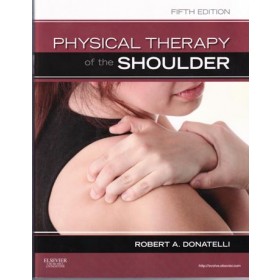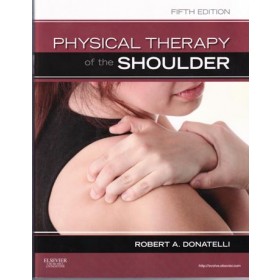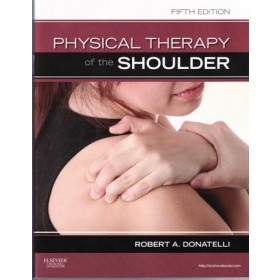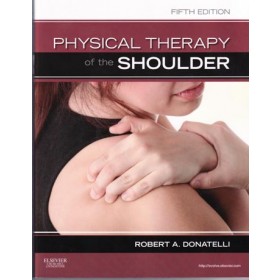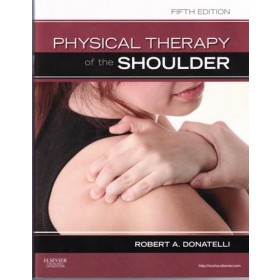Details
Physical Therapy of the Shoulder, 5th Ed: Module 3
SKU: 733
By Robert A. Donatelli, PhD, PT, OCS
This course is offered in cooperation with Elsevier Science and utilizes the textbook, “Physical Therapy of the Shoulder, 5th Ed”, c2012, edited by Robert A. Donatelli, PhD, PT, OCS. Dr. Donatelli is a certified Orthopedic Clinical Specialist with over 30 years of clinical hands-on experience.
This textbook is the leading reference on the shoulder and is now completely up-to-date with state-of-the-art rehabilitation and surgical techniques. It is an essential resource to the therapist, providing valuable information on functional anatomy, the mechanics of movement, neurologic, special, and surgical considerations and evaluation and treatment. This new edition provides new information, concepts, and evaluation of physical therapy and dysfunction based on the APTA Guide to Physical Therapy Practice, 2nd Ed and integrates these practice patterns with rehabilitation of the shoulder.
These courses are essential to therapists treating shoulder injuries in all rehabilitation settings!
Module 1 covers the mechanics of movement and evaluation including the guide to practice, functional anatomy and mechanics, throwing injuries and examinations and evaluation of the shoulder
Module 2 covers neurologic considerations including the interrelationship of the spine, rib cage and shoulder, neural tissue evaluation and treatment, sensory integration and neuromuscular control of the shoulder and evaluation and treatment of brachial plexus lesions.
Module 3 covers special considerations including impingement syndrome and impingement-related instability, frozen shoulder, evaluation and rehabilitation of rotator cuff pathologic conditions and rehabilitation and visceral pain referred to the shoulder
Module 4 covers treatment approaches including manual therapy, muscle length testing and electromyographic evidence for manual strength testing and exercises for the shoulder, rotator cuff repairs and surgical approaches to shoulder instabilities
Course Length: 8.0 contact hours
Instructional Level: Beginner/Intermediate
This package contains the required reading and test materials for Module 3 only.
Physical Therapy of the Shoulder, 5th Ed: Module 3
Course Goals and Objectives:
Course Goals:
This course is intended to instruct the student through self-paced study on impingement syndrome and impingement-related instability, frozen shoulder, etiology and evaluation of rotator cuff pathologic conditions and rehabilitation and visceral referred pain to the shoulder.
Student Objectives:
At the end of this course the student will be able to:
1. Identify 6 categories of extrinsic factors of impingement syndrome
2. Identify 3 categories of intrinsic factors of impingement syndrome
3. Identify 3 stages of shoulder impingement and the clinical presentation and treatment principles for each one.
4. Identify the difference between primary and secondary tensile overload in rotator cuff pathologies.
5. Identify the primary cause of rotator cuff disease in athletes
6. Identify 5 closed-chain upper extremity activities and treatment progressions for those activities
7. Identify the 3 stages of a frozen shoulder
8. Identify the findings of research studies of the effectiveness of physical therapy for the frozen shoulder
9. Identify 4 ways the rotator cuff musculature functions to stabilize the glenohumeral joint
10. Identify 6 etiologic factors associated with rotator cuff pathologic conditions
11. Identify the difference between primary and secondary compressive disease of the rotator cuff
12. Identify the structures involved with posterior or “undersurface” impingement of the rotator cuff
13. Identify 3 primary types of rotator cuff tears and their method of injury
14. Identify 3 primary scapular dysfunctions
15. Identify 3 special tests for shoulder impingement
16. Identify 7 special tests for glenohumeral joint instability
17. Identify the muscle of the rotator cuff that has the greatest force potential in relation to its cross-sectional size
18. Identify 3 principles of both non-operative and postoperative rehabilitation of the rotator cuff
19. Identify 3 factors influencing the rehabilitation of surgically repaired rotator cuff tears
20. Identify 6 reasons why screening for visceral disease is important
21. Identify 5 characteristic of visceral pain
22. Identify 12 questions to help detect visceral pathology or disease.
23. Identify 10 warning signs that may indicate a possible visceral pathologic condition or disease
24. Identify 7 theories on visceral referred pain
25. Identify 10 visceral organs capable of referring pain to the shoulder
